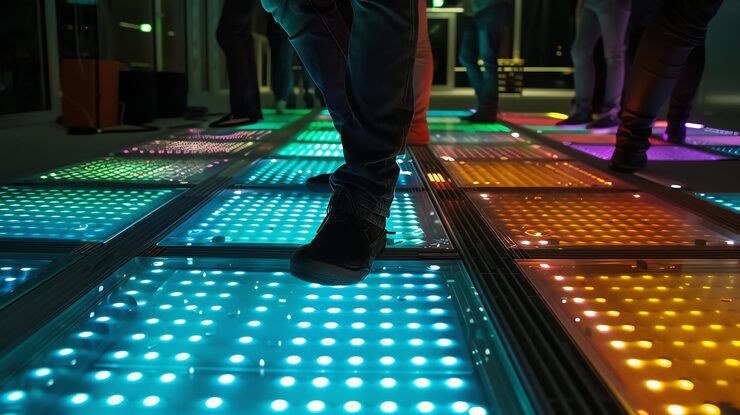LED floor lights are freestanding lighting fixtures that use energy-efficient Light Emitting Diodes (LEDs) to illuminate residential, commercial, and industrial spaces. Unlike traditional incandescent or halogen floor lamps, LED options offer a longer lifespan, lower power consumption, and a more versatile range of designs. These lights are commonly used for ambient, task, or accent lighting in living rooms, bedrooms, offices, showrooms, and galleries.
As lighting needs evolve with modern interior trends, LED floor lights are becoming more diverse in style, function, and technological integration. From minimalist standing poles to multi-head reading lamps and color-changing smart lights, the choices are wide-ranging.

Why LED Floor Lights Matter Today
LED floor lights are gaining popularity for several important reasons:
-
Energy Efficiency: LEDs use up to 80% less energy than traditional bulbs, significantly reducing electricity bills.
-
Design Flexibility: Available in sleek, modern, or classic styles to match any decor.
-
Improved Lighting Quality: LEDs offer brighter, directional, and customizable lighting, reducing eye strain.
-
Sustainability: Eco-friendly materials and less heat output contribute to a greener environment.
-
Smart Features: Many LED floor lamps now come with app control, voice integration (Alexa, Google Assistant), and dimmable features.
These lights cater to a wide range of users—from homeowners seeking aesthetic upgrades to offices aiming for better productivity lighting.
Recent Updates and Design Trends in LED Floor Lighting
Over the past year, LED lighting has seen rapid innovation in both form and function. Notable trends as of 2024–2025 include:
| Trend | Description |
|---|---|
| Smart Lighting Integration | Voice-controlled and app-based LED floor lamps now allow scheduling, mood settings, and brightness control. |
| Minimalist and Space-Saving Designs | Tall, narrow, or corner-based designs are ideal for smaller apartments or studios. |
| Color Temperature Adjustability | Tunable white light (2700K to 6500K) lets users adjust between warm and cool light modes. |
| Rechargeable and Cordless Lamps | Battery-powered LED floor lights are ideal for temporary setups or areas without nearby power outlets. |
| Sustainable Materials | Eco-friendly bamboo or recycled plastic finishes are increasingly used in designs. |
This evolution in style and functionality is shaping how consumers choose lighting products that suit both aesthetic and utility preferences.
Rules and Policies Around LED Floor Lighting
While LED floor lights typically don’t require regulatory approval for home use, there are some general guidelines and certifications that consumers and manufacturers should be aware of:
-
Energy Star Certification (USA): Indicates energy efficiency compliance.
-
BIS Certification (India): Required for imported or domestically manufactured LED lighting products to ensure safety and quality.
-
CE Marking (Europe): Confirms that the product meets health, safety, and environmental protection standards.
-
RoHS Compliance: Ensures that LED lights do not contain hazardous materials like lead or mercury.
-
Import Duties & GST: Vary by country; in India, LED lights fall under 12% GST as of 2025.
Consumers are encouraged to purchase certified products to ensure durability and environmental safety.
Tools and Resources to Help You Choose LED Floor Lights
If you're shopping for LED floor lights or planning a lighting setup, the following tools and websites may be helpful:
-
Lighting Design Calculators (e.g., Visual-3D from Acuity Brands): Helps simulate lighting setups for different rooms.
-
Amazon, Flipkart, Wayfair: For browsing verified user reviews and comparing features.
-
Lumens Calculator Apps: Determine the appropriate brightness (in lumens) based on room size and purpose.
-
Pinterest and Houzz: Great for visual inspiration and trending decor ideas.
-
Smart Home Integration Apps (like Tuya, Philips Hue, or Mi Home): For managing smart floor lamps remotely.
-
YouTube Tutorials: Demonstrations of lamp installation and reviews of popular products.
Using these tools can help make informed decisions based on space requirements, energy goals, and aesthetic preferences.
Frequently Asked Questions (FAQs)
Q1. What are the main types of LED floor lights?
A1. Common types include arc floor lamps, tripod lamps, torchiere lamps (upward lighting), reading lamps, and color-changing smart floor lights.
Q2. How do I choose the right brightness for a floor lamp?
A2. Brightness is measured in lumens. For ambient lighting, 300–500 lumens is sufficient. For reading or task lighting, go for 800+ lumens.
Q3. Are LED floor lamps suitable for small rooms?
A3. Yes, many are designed to be slim and space-efficient, making them ideal for apartments, dorm rooms, or offices with limited floor space.
Q4. Can LED floor lights be used with smart home systems?
A4. Absolutely. Many models now support Alexa, Google Assistant, or app-based controls for convenience and automation.
Q5. Do LED floor lights get hot like traditional lamps?
A5. No, LEDs emit very little heat, making them safer for households with children or pets.
Final Thoughts
LED floor lights offer a blend of function, efficiency, and style that few other lighting options can match. With innovations in design and technology, they’ve become essential components in modern interior lighting. Whether you’re creating a cozy reading nook, upgrading your workspace, or enhancing your living room ambiance, understanding the various types and features of LED floor lights will help you make the best choice for your needs.
Before buying, consider factors like brightness, adjustability, material, and smart compatibility. Use certified products to ensure safety and energy compliance, and take advantage of online tools and resources to find the perfect lighting solution.
